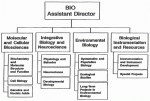Following an action recommended by its “Task Force Looking to the 21st Century” in October 1991, the National Science Foundation (NSF) has reorganized the Directorate for Biological, Behavioral, and Social Sciences, under which the LTER Program was developed. Two separate directorates, Biological Sciences (BIO) and Social, Behavioral, and Economic Sciences (SBE), have been established. Following is a brief description of the restructuring of the divisions within the BIO Directorate, including the Division of Environmental Biology (DEB) which now contains the LTER Program (excerpted from the NSF Bulletin, Vol. 19, No. 8):
Biological Instrumentation and Resources (BIR)
includes the Instrumentation and Instrument Development and Special Projects Programs for the former Division of Instrumentation and Resources. These two program names were unchanged. BIR funds most of the major infrastructure within the BlO Directorate.
Environmental Biology (DEB) includes Ecology, Systematic Biology, Population Biology, and Ecosystems Studies of the former Division of Biotic Systems and Resources. Three new program clusters were established: Systematic and Population Biology, Ecological Studies, and Long- Term Projects in Environmental Biology. DEB research advances scientific understanding of the factors governing the interrelationships of environmental biology from individual organisms to complex ecological systems.
Integrative Biology and Neuroscience (IBN) includes the developmental biology and physiological processes programs from the former Cellular Biosciences Division, the Neuroscience and Biological Basis of Behavior programs from the former Behavioral and Neural Sciences Division, and the Physiological Ecology program from the former Biotic Systems and Resources Division. Three new program clusters were established: Physiology and Behavior, Neuroscience, and Developmental Biology. IBN research emphasizes the integration of molecular, subcellular and cellular biology approaches to better understand the development, function and behavior of organisms in both laboratory and natural settings.
Molecular and Cellular Biosciences (MCB). Three new program clusters were established from the former programs of Molecular Biosciences and Cellular Biosciences Divisions: Biochemistry and Molecular Structure and Function, Cell Biology, and Genetics and Nucleic Acids. MCB funding increases fundamental understanding of the chemical, physical, genetic and cellular processes underlying biological phenomena.

 Enlarge this image
Enlarge this image